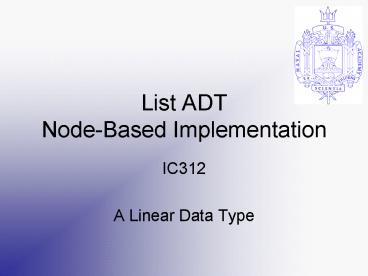List ADT NodeBased Implementation - PowerPoint PPT Presentation
1 / 24
Title:
List ADT NodeBased Implementation
Description:
Elements of array are ... Drawback! Not great for position-based list ... A major drawback to using an array to implement the List ADT is the fact that ... – PowerPoint PPT presentation
Number of Views:85
Avg rating:3.0/5.0
Title: List ADT NodeBased Implementation
1
List ADTNode-Based Implementation
- IC312
- A Linear Data Type
2
Node-Based Changes
- Elements of array are juxtaposed, by definition,
in memory - Allows us to use indices to identify elements
- We dont know placement
- of nodes in memory
0 1 2 3
3
Node-Based Changes
- Metal Picture of Memory (array-based)
- Mental Picture of Memory (node-based)
Tail
Head
Tail
Head
4
Node-Based List
- We need to make sense of the mess
Tail
Head
5
Nodes More than just our data
- Hopefully you see importance of knowing location
of next element in list - Each node has to keep that information
- List knows where it starts and ends
- Each node knows next step in between
6
Node
- class NodeltGenericgt
- //public methods
- private Generic data
- private NodeltGenericgt next
7
Singly-Linked List
- Name comes from links between nodes
- Each node has a single link
- Each node points to next node in list
- Last node points to
8
Drawback!
- Not great for position-based list
- We know where the next node is, but what about
node x ? - Other problems?
9
One Way
- With singly-linked lists can only move one way
- To get to second to last, must start at beginning
10
Adding to Middle of List
- We also have issues adding to middle of list
?
BAD!
?
Ø
?
?
GOOD!
Ø
11
Losing Track of Elements
- We cant lose track of elements
- We only know where an element is because node
before keeps track of it - Must copy location before erasing it
- Similar with deleting
12
Deleting
- Make previous node skip one in list
- Now nothing points to deleted node
- Java garbage collection will get it
13
Benefits?
- There are drawbacks to node-based list
- What are some benefits?
- List has no maximum size
- Inserting and removing elements is done in
constant time (unless position is important) - Dont have to shift elements
- Still, we have that one-way problem
14
How to Solve One-Way Problem?
- Use array-based list
- Have links that go both ways
15
Doubly-Linked List
- Links go both ways
- Node needs next and previous
- Allows you to travel forward and backward through
list
Ø
Ø
Head
Tail
16
Doubly Linked Node
- class NodeltGenericgt
- //public methods
- private Generic data
- private NodeltGenericgt next
- private NodeltGenericgt previous
17
Adding to Middle of List
Ø
Ø
18
Removing
- Make your previous next be your next
- Make your nexts previous be your previous
19
Interface
public interface ListltGenericgt int size()
boolean isEmpty() Generic get(int
index) Generic set(int index, Generic
entry) boolean add(Generic entry)
boolean add(int index, Generic entry)
Generic remove(int index)
20
Implementations
- int size()
- boolean isEmpty()
21
Implementations
- Generic get(int index)
- Generic set(int index, Generic entry)
22
Implementations
- boolean add(Generic entry)
- boolean add(int index, Generic entry)
23
Implementation
- Generic remove(int index)
24
Homework
- Due Monday, 10 September
- Read section 2.5 (Casting and Generics)
- Read sections 3.2 and 3.3 (Linked Lists)
- Dynamic Array Expansion.
- A major drawback to using an array to implement
the List ADT is the fact that the size of the
array is fixed, thereby imposing an arbitrary
upper limit on the number of elements one can
store in the list. One way to overcome this
limitation is with dynamic array expansion. The
idea is this when the array becomes full, create
a new array that is larger than the original
array, copy the contents of the original array
into the new array, and reset the reference
variable that was point to the original array so
that it now points to the new array. In
practice, each new array it typically twice the
size of the old array. - On the course web page under In Class Examples
there is a copy of the array-based list
implementation. Your job is to modify the code
and implement dynamic array expansion. You can
use either the Object version, or the generic
version of List. In addition, write a class that
will test your updated List class to verify that
it does indeed increase capacity as necessary.
Remember, there are two add methods in the List
ADT and therefore two places in the code where
the list can become full. - Deliverables A hard copy of your updated List
class and a screen shot of your test programs
execution.































